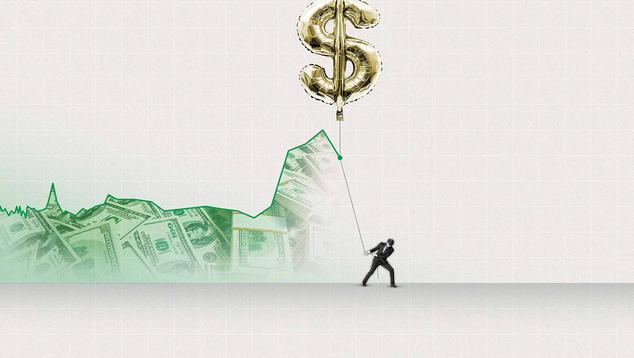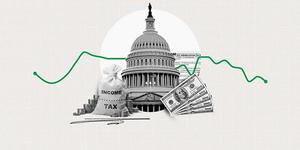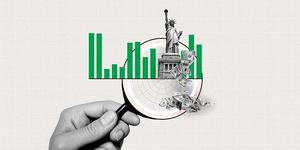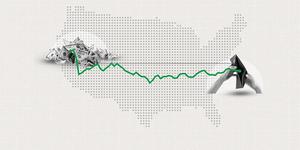WASHINGTON, D.C. — Nearly three in 10 Americans, 29%, say inflation or the high cost of living is the most important financial problem facing their family today, down from 41% last year and 35% in 2023.
Still, today’s reading far exceeds the levels measured before inflation began to spike in 2021, and is large enough to earn the top spot on Gallup’s annual measure of consumers’ financial stressors, as it has each year since 2022.
Gallup’s April 1-14 Economy and Personal Finance survey finds that housing costs and lack of money are the next-most-commonly mentioned financial challenges after inflation, each named by 12% of U.S. adults. Healthcare costs (7%), stock investments (6%), taxes (5%) and debt (5%) are each named by at least 5% of Americans in response to the open-ended question.
Though inflation remains the top issue by a wide margin, the 12-percentage-point drop in mentions of it is the biggest change since last year. There have also been five-point increases in the percentages mentioning stock investments and lack of money.
The poll finds 44% of Americans rating their financial situations as excellent or good, 37% as “only fair” and 18% as poor — unchanged from last year, but significantly worse than the 57% excellent/good rating from early 2021, before the period of higher inflation began. Meanwhile, a record-high 53% currently say their financial situation is getting worse, while 38% say it is getting better.
The poll was conducted during a period of stock market volatility after the Trump administration announced sweeping new tariffs on most U.S. trading partners on April 2. The market plunged in the immediate aftermath of the announcement, but stock values recovered somewhat after Trump on April 9 paused many of those tariffs for 90 days.
Inflation Top Financial Problem in All Income Groups
Inflation is most often named the top financial problem by Americans at all income levels, but middle-income people (38%) mention it more than do lower- or upper-income people (27% and 24%, respectively). Housing costs rank among the top issues for all three groups, but lack of money or low wages eclipses housing among lower-income people.
Stock market investments and retirement savings rank among the top problems for upper-income people but not for lower- and middle-income people.
Declines in mentions of inflation as the most important family financial problem are apparent among all income groups, but disproportionately so among upper-income Americans, with the 24% this year down 17 points from 2024. That compares with a nine-point drop among middle-income Americans and six points among lower-income Americans in the past year.
Retirement, Serious Medical Events, Standard of Living Worry Americans
A separate question in the survey asked Americans how much they worry about each of nine financial difficulties that could affect them. Of these, Americans are most likely to say they worry about not having enough for their retirement (59%), not having enough to pay medical costs for a serious illness or accident (59%) and not being able to maintain their standard of living (57%). Additionally, 53% are worried about not getting a good return on their investments.
Americans are less worried about not having enough to pay for normal healthcare costs (45%), not being able to pay their normal monthly bills (42%) and not being able to pay their rent, mortgage or other housing costs (38%).
One-third of all Americans worry about paying the cost of a child’s college, a figure dampened by the fact that it is not an issue for everyone. The figure is much higher, 64%, among adults who have children under age 18.
Making minimum credit card payments is also a low-ranking concern.
As would be expected, lower-income Americans worry more about these financial challenges than middle- and upper-income Americans do. The largest gap in worry between lower- and upper-income people is for paying normal monthly bills, something 71% of those with lower incomes and 24% of those with upper incomes worry about. One issue — investment returns — sparks similar levels of worry across the three income groups.
Standard of Living Worries Have Increased the Most in Recent Years
More Americans are worried about these financial challenges than were in 2019 (before the COVID-19 pandemic) and 2021 (before the surge in inflation began), but there has been little change in the past two years since inflation has moderated. The exception to this pattern is worry about not having enough for retirement, which has subsided over the past two years, perhaps tied to stock value gains in 2023 and 2024.
The economic shocks of the past five years have had the most effect on Americans’ worry about being able to maintain their standard of living, which is up 15 points since 2019. Most of that increase occurred between 2021 and 2023, after inflation climbed. The 57% currently worried about their standard of living essentially matches the high of 58% recorded in 2011 during a period of slow GDP growth and high unemployment after the Great Recession.
Significantly more Americans also worry about not having enough money to pay medical costs for a serious medical situation and not being able to pay housing costs, with eight-point increases in each since 2019.
Current levels of worry for most of these issues are just below their record highs, generally registered in 2011 or 2012.
Americans at all income levels are more worried now about these financial matters than were in 2019, and the sizes of the increases have been fairly similar across income subgroups. That, however, is not the case for increased worry about making minimum credit card payments, which is largely confined to middle- and lower-income adults, and paying for college, which has not shown meaningful change for any subgroup.
Implications
Inflation continues to be a top-of-mind financial concern for Americans. This is the case even though the peak in price increases happened nearly three years ago, and inflation rates have been near the Federal Reserve’s 2% target rate over the past year. Americans are likely still feeling the pinch from higher prices resulting from the cumulative effects of elevated inflation in recent years, with wage growth only more recently keeping up with price increases.
Consequently, Americans worry about a range of financial matters, particularly in being able to maintain their standard of living. Going forward, whether these concerns worsen or abate will likely depend heavily on the effect that President Donald Trump’s economic policies have on consumer prices, employment, wages and stock values. For now, Americans are worried about the threat of inflation from tariffs, with two-thirds saying Trump’s tariffs on U.S. trading partners are “very likely” to increase prices on the products they buy.
To stay up to date with the latest Gallup News insights and updates, follow us on X @Gallup.
Learn more about how the Gallup Poll Social Series works.
View complete question responses and trends (PDF download).





